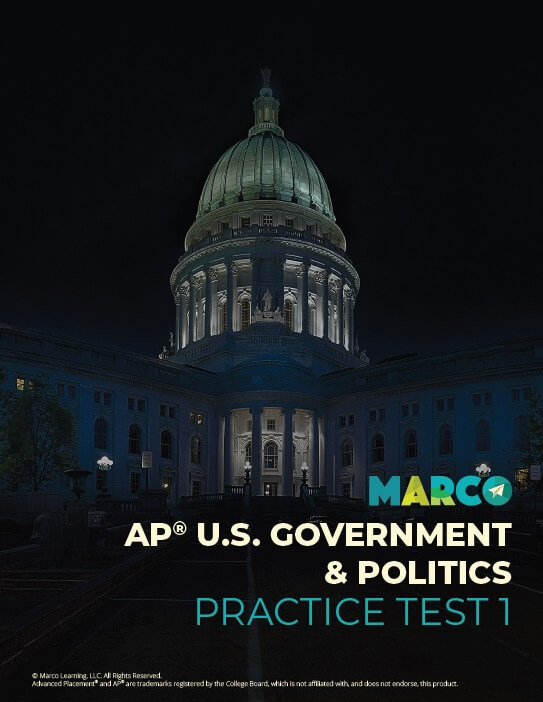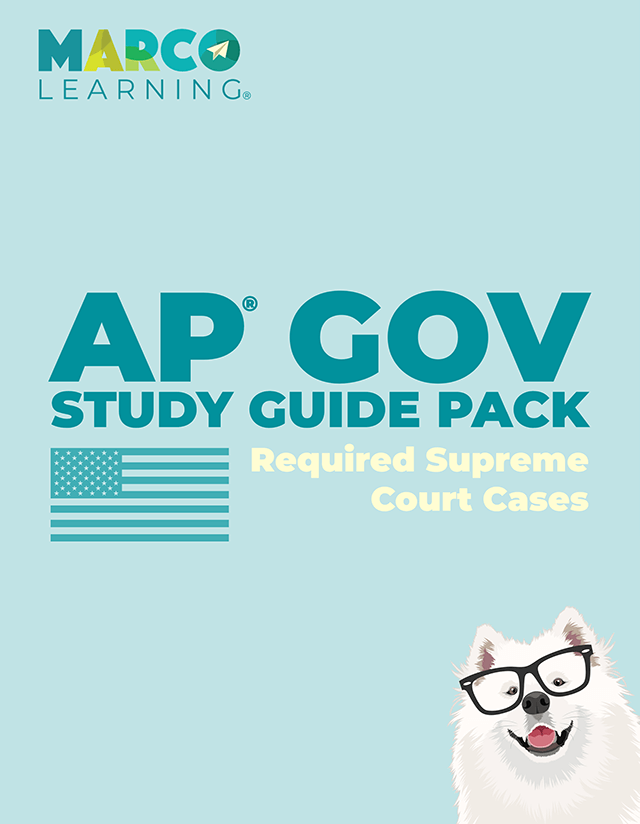


To score well on your AP U.S. Government and Politics Exam, it is important to become familiar with all of the required Supreme Court cases. In the free-response section of your AP® U.S. Government Exam, you will have to answer four essay questions. The third of these questions is a SCOTUS comparison essay, in which you will be required to compare a non-required Supreme Court case with a required Supreme Court case, so get to know each required Supreme Court case as well as possible!
The required Supreme Court cases for the AP U.S. Government and Politics Exam in 2021 are:
Marbury v. Madison (1803)
McCulloch v. Maryland (1819)
Schenck v. the United States (1919)
Brown v. Board of Education (1954)
Engel v. Vitale (1962)
Baker v. Carr (1962)
Gideon v. Wainwright (1963)
Tinker v. Des Moines Independent Community School District (1969)
New York Times Co. v. United States (1971)
Wisconsin v. Yoder (1972)
Roe v. Wade (1973)
Shaw v. Reno (1993)
United States v. Lopez (1995)
McDonald v. Chicago (2010)
Citizens United v. Federal Election Commission (2010)
PRECEDENT
Schenck v. United States (1919)—argued that First Amendment rights could be limited by the states if the speech posed a “clear and present danger.”
FACTS OF THE CASE
In 1971, with the United States six years into a military action in North Vietnam and civil protests throughout the United States, the Secretary of Defense commissioned an extensive report of the United States’ involvement in Vietnam. The classified and top-secret report was leaked to The New York Times by Daniel Ellsberg, a contractor who helped compile the document. The newspaper began publishing articles outlining the information contained in the study, which would come to be known as the Pentagon Papers. Almost immediately, the White House administration under President Nixon issued a cease and desist order to The New York Times and The Washington Post to try to prevent any future publication of materials from the Pentagon Papers. The presidential administration argued that the publication of this information needed to be prevented due to national security concerns. The New York Times and The Washington Post both challenged the cease and desist orders. The court appeal for The New York Times restricted the publication of the materials, while the court challenge by The Washington Post resulted in a ruling that determined that the newspaper did not have to follow the government’s order. The New York Times challenged the lower court’s decision through an emergency appeal to the Supreme Court.
THE DECISION
In a 6-3 decision, the Court ruled that The New York Times could continue to publish excerpts from the Pentagon Papers because the government had not met the burden of showing that prior restraint was justified. The ruling established that prior restraint of the First Amendment right of freedom of the press could only occur if the government could meet a “heavy burden showing justification for the imposition of such a restraint.”
IMPACT
The ruling in The New York Times v. United States provided a broad precedent for limiting prior restraint in the press, even in cases of national security. Although this case is often seen as a victory for a free press, its utility is hindered by the fact that the Court’s decision was divided among six different concurring opinions, each of which provided different rationale for the ruling. Justice William Brennan Jr., for example cited the clear and present danger test from Schenck v. United States (1919) to argue that the prior censorship could be allowed if specific consequences of publishing were articulated. The government’s claim of national security, in Justice Brennan Jr.’s opinion, was simply too vague to meet this benchmark. Meanwhile, Justice Hugo Black argued in his opinion that it is never constitutional for the government to attempt prior restraint of the press. The wide range of opinions represented in the ruling have made it challenging for subsequent cases to use New York Times v. United States as precedent.
SUBSEQUENT CASES
Nebraska Press Association v. Stuart (1976) – The Burger Court used the case to underscore the idea that prior restraint on speech and publication was an intolerable restriction on the First Amendment. The ruling argued that the state could not restrict the press from publishing information about a confession made by a suspect before the trial had occurred.
KEY TERMS
Prior Restraint Prior restraint is a type of censorship in which a government limits certain expression of free speech before they occur. This typically takes the form of attempting to stop publication of materials thought to be dangerous, threatening, or indecent, but it can also take the form of overly burdensome regulations that effectively prevent controversial speech.
The Pentagon Papers, which was officially titled Report of the Office of the Secretary of Defense Vietnam Task Force, provided a detailed history of the role of the United States in Vietnam. The top-secret document was published by The New York Times as part of an exposé that argued that the United States government had ordered the execution of President Diem, secretly enlarged the scope of its military effort to include Cambodia and Laos, and did not have an exit strategy for the conflict.
 Help
Help